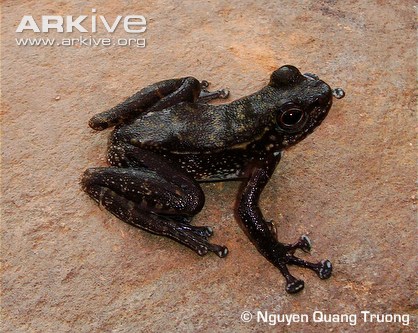| Citation |
|
Description |
Geographic Range [top]
Range Description: This species is currently known from 200-1,352 m asl in central and northern Viet Nam and Laos (Inger and Kottelat 1998, Stuart 1999, Orlov et al. 2002, Stuart 2005, Bain et al. 2007, Nguyen et al. 2009, Pham et al. 2015, Jodi Rowley unpubl. data). Similar habitat and elevations to those in its known localities also extend into small parts of northern Thailand. Further surveys in these areas may uncover its presence, therefore its range has been projected beyond known sites to include areas of suitable habitat. This species estimated extent of occurrence (EOO) is 253,086 km2, which consists of four threat-defined locations.
Countries occurrence:
Native:
Lao Peoples Democratic Republic; Viet Nam
Additional data:
? Number of Locations: 4
? Lower elevation limit (metres): 200
? Upper elevation limit (metres): 1352
Range Map: Click here to open the map viewer and explore range.
Population [top]
Population: Little is known about this species abundance except that it has been detected in a number of surveys (Inger and Kottelat 1998, Stuart 1999, Orlov et al. 2002, Stuart 2005, Bain et al. 2007, Nguyen et al. 2009, Pham et al. 2015, Jodi Rowley unpubl. data) and described as locally abundant in parts of Viet Nam (Jodi Rowley pers. comm. January 2016). Deforestation continues to affect habitat in the species known and predicted range (Sodhi et al. 2009) and along with logging and infrastructural development, is very likely causing declines (Pham et al. 2015).
Current Population Trend: Decreasing
Additional data:
Habitat and Ecology [top]
Habitat and Ecology: This species occurs in evergreen forest and is closely associated with fast-flowing, rocky stream sections and cascades (Stuart 1999, Stuart 2005, Pham et al. 2015, Jodi Rowley unpubl. data). In Viet Nam, eggs, larvae and metamorphs have been observed between May and July (Pham et al. 2015, Jodi Rowley unpubl. data), and in Lao PDR eggs and larvae have been observed in March (Inger and Kottelat 1998). This species deposits its adhesive egg clutches on wet vertical rock faces within the splash zone of cascades (Inger & Kottelat 1998, Pham et al. 2015, Jodi Rowley unpubl. data). Larvae occupy the same rock faces; sucking mouth parts enable them to cling to and climb across the slippery surfaces (Inger and Kottelat 1998, Pham et al. 2015, Jodi Rowley unpubl. data).
Systems: Terrestrial; Freshwater
Continuing decline in area, extent and/or quality of habitat: Yes
Movement patterns: Not a Migrant
Use and Trade [top]
Use and Trade: This species is known to be collected in some areas for local use as a food source (Jodi Rowley unpubl. data). The rates at which the species is harvested are not known.
Threats [top]
Major Threat(s): This species is sensitive to changes in hydrological conditions (e.g. by damming) and may also be affected by habitat loss due to logging and the development of infrastructure (Pham et al. 2015). The conversion of natural forest to agricultural land is also ongoing in much of Viet Nam and Lao PDR (Sodhi et al. 2009) and recent satellite imagery reveals that land cleared for agriculture comprises parts of this species predicted range, and individuals have been observed in slightly disturbed forest (Jodi Rowley unpubl. data); these activities are likely impacting the suitability of this species habitat. Additionally, this species is harvested throughout parts of its range to be used as food (Jodi Rowley unpubl. data). The degree to which these processes are threatening the species is unclear and may be determined by further investigation.
Conservation Actions [top]
Conservation Actions: Conservation Actions
This species is known from Pu Mat National Park and both Pu Hoat and Pu Hu Nature Reserves in Viet Nam (Pham et al. 2015, Jodi Rowley unpubl. data), as well as Nakai-Nam Theun National Biodiversity Conservation Area in Laos (Inger and Kottelat 1998, Stuart 1999). A large number of other protected areas are also included in its predicted range; the species is probably represented in many of these also.
Conservation Needed
Addressing the lack of data is the first step towards ensuring this species long-term persistence
Research Needed
Further research on its true distribution, harvest rates, threats, and the size and trends of its population would inform conservation decisions.
Citation: IUCN SSC Amphibian Specialist Group. 2016. Amolops cremnobatus. The IUCN Red List of Threatened Species 2016: e.T29435A88161090. http://dx.doi.org/10.2305/IUCN.UK.2016-3.RLTS.T29435A88161090.en. Downloaded on 19 October 2018.
Disclaimer: To make use of this information, please check the .
Feedback: If you see any errors or have any questions or suggestions on what is shown on this page, please provide us with feedback so that we can correct or extend the information provided
|

